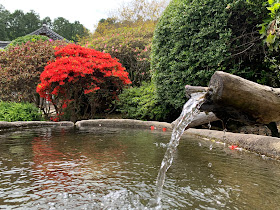In the lineup of spring flowers, it's mume ( /moo-may/ ) time. We have one of these trees in Pruggio Park. Sometimes they are called a double cherry blossom. As you can see, the blooming window is almost over.There are not as many of these trees around, but Seonamsa Temple on Cheogyesan Mountain has an orchard of them, so Seonamsa Temple it was for our outing.
There is a short walk of about 1km from the parking lot to the temple.










This granite stone bridge, named Seungseon Bridge, was built during the Joseon Dynasty in 1713 over a period of 6 years. It is also called a rainbow bridge. The thing dangling in the center used to be a dragon and was this was considered a very ornate bridge of its time. The dragon head was intended to ward off evil spirits. Seungseon means 'ascending immortals.'
 |
| Trish, Shelley, Chris, Kate |
 |
| Chris, Shelley, Linda, Trish, Lotte |
There were actually two bridges pretty close together, mirroring each other.
This is called the Gangseon Pavilion. It's the building you can see peeking through arc of the bridge.


I would love to know what these rocks beside the pavilion have carved into them.





Iljumun is the first entrance gate. The original gate was destroyed and rebuilt in 1540. That one was destroyed again during the Byongjahoran Battle and rebuilt in 1719. It's also called the 'One-Pillar Gate' because when viewed from the side it looks like it is supported by a single pillar. This was not done for looks only; it symbolized the one true path of enlightenment which supports the world. It is the boundary between the Buddhist temple and a human's worldly life. The gate symbolized ritual purification and one must leave all their worldly desires before entering the temple.
I was not aware of that and did not set my worldly desires aside before entering. Oops.

This old tree looks like it could have been planed in 1540. Poor thing was on its last leg.


Supposedly these bells get rung three times daily, but I have seen a lot of temples in the past year and a half and have yet to hear them being rung.


The original buildings of Seonaman were built sometime in the latter half of the first century. They were added onto in the 900s for a total of 13 buildings that contained a statue of Buddhas, 12 temples, 26 chambers, and 19 hermitages.
This was a hollowed out log with little people and offerings in it.
In 1597 Seonamsa was damaged by, you guessed it, Japanese invaders. Every building that contained a Buddha statue was burned. It was added onto in the late 1600s.
The temple area has actually been through other fires, restorations and additions since.
A mume tree!
Since we were at the end of the blossoms, the ground was almost as pretty as the trees.














There are about 50 Seonam-Maes, or Seonam Mume trees, here in the temple. The orchard was planted roughly 600 years ago. The quote from a plaque says, "When the Seonam Mumes are in full flower, we visit to the Seonamsa in order to watch and appreciate them." Profound stuff, huh? 😜 I guess they were right, though. The trees were in bloom and I was there watching and appreciating them.




The buildings have been refurbed, but the concrete statues are very aged. If only they could talk and share the stories of what they have seen over the years.




This monument was erected in the 1707 to commemorate the rebuilding of the temple. The inscription reads, "Seonam Temple, destroyed by fire during the second Japanese Invasion, was renovated by Monk Yakhyu and others."
The turtle-shaped base bears a dragon head on top. It is typical of monuments constructed during the Joseon Dynasty.
These are metasequoia trees. Feels like Redwood Forest. (I have not been there yet, but this is what I imagine it like.)

These are metasequoia trees. Feels like Redwood Forest. (I have not been there yet, but this is what I imagine it like.)

Most of the camellia blooms have faded and fallen to the ground weeks ago, but these peppermint blooms were still clinging to the tree.












This wishing well was fully functioning and turning with water.
This old fella, called Wasong, or Reclined Pine tree, was planted with the mume orchard and is dated to be about 600 years old. Just like an old man, he needs a few crutches to stay upright.
There are four little stone basins on the grounds. Each basin has a different function based on the order of water flow. The first is for water offered up to Buddha, the second for the water to clean food for Buddha, the third to be used by humans, and the fourth is for all other purposes.
They also collect petals from the mumes which make pretty pictures.


















































No comments:
Post a Comment